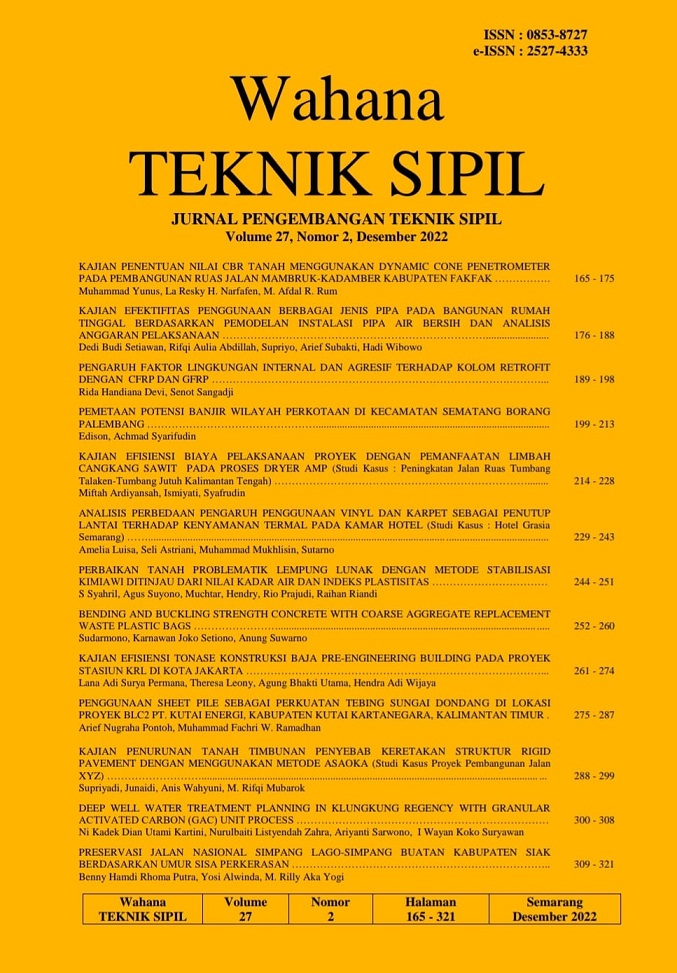PENGGUNAAN SHEET PILE SEBAGAI PERKUATAN TEBING SUNGAI DONDANG DI LOKASI PROYEK BLC2 PT. KUTAI ENERGI, KABUPATEN KUTAI KARTANEGARA, KALIMANTAN TIMUR
DOI:
https://doi.org/10.32497/wahanats.v27i2.4148Keywords:
perubahan tinggi muka air, sheet pile, stabilitas lerengAbstract
The collapse of the banks of the Dondang river at the BLC2 project site of PT. Kutai
Energi caused the barge to not dock and the conveyor to be unusable. One of the
causes of landslides is changes in river water levels which cause the soil around the
river banks to become saturated and unstable. The research begins with a survey
and data collection related to the research location. Analysis using GeoStudio
(Slope/W) 2012 software was carried out with two models, namely when the river
water level is normal and when the river water level is in a flooded condition. The
results of the analysis show that the critical condition occurs in the second condition
where the river water level is in a flood condition. In these conditions, it is known
that in the existing condition of the slope without reinforcement, the value of safety
number (SF) = 1.125 is obtained. On the other hand, when the pile reinforcement is
given, the slope safety score increases to 1.741 which indicates that the plaster can
overcome the sliding on the cliff due to the influence of the river water level
References
Agatha, M.N., Adha, I., dan Zakaria, A., 2017, Perencanaan Sheet Pile dengan menggunakan Program Plaxis (Studi Kasus : Jalan Padang Tambak ”“ Liwa KM.227+400), Jurnal Rekayasa Sipil dan Desain (JRSDD), Vol. 5 No. 2. E-ISSN: 2715-0690.
Atibrata, A.L., 2020, Perencanaan Dinding Penahan Tanah Jenis Corrugated Concrete Sheet Pile (CCSP) Pada Pekerjaan Galian Apartemen Bengawan Malang, Fakultas Teknik Universitas Muhammadiyah Surakarta. Surakarta.
Bowles, J.E., 1984, Sifat-sifat Fisik & Geoteknis Tanah (Mekanika Tanah), Erlangga, Jakarta.
Chasanah. U., 2012, Analisis Stabilitas Lereng Dengan Perkuatan Geotekstile Menggunakan Program Geoslope, Fakultas Teknik Universitas Sebelas Maret, Surakarta.
GeoStudio, 2022. SLOPE/W: Slope Stability Analysis. https: //www.geoslope.com/ products/ slope-w diakses 25 Juni 2022.
Hardiyatmo, H.C., 2018, Mekanika Tanah I, Gadjah Mada University Press, Yogyakarta.
Hertiany, I.R., dan Asyifa A., 2017, Perencanaan Konstruksi Sheet Pile Wall Sebagai Alternatif Pengganti Gravity Wall (Studi Kasus Proyek Sindu Kusuma Edupark, Yogyakarta), Jurnal INERSIA, Vol. 10 No.1, Mei 2014. http://dx.doi.org/10.21831 /inersia.v10i1.4429.
Indrawahjuni, H., 2011, Mekanika Tanah II, Penerbit Bargie Media, Malang.
Nofrizal, N., Silfia, F., 2020. Analisa Pengendalian Banjir Akibat Peluapan Debit Aliran Dengan Perkuatan Tebing Tipe Sheet Pile “Studi Kasus Sungai Batang Lumpo Kabupaten Pesisir Selatan”, Rang Teknik Journal, Vol. 3 No.2. https://doi.org/10.31869/rtj.v3i2.1822.
Putra., 2014, Analisis Distribusi Kecepatan Aliran Sungai Musi (Ruas Sungai: Pulau Kemaro sampai dengan Muara Sungai Komering), Jurnal Teknik Sipil dan Lingkungan, Vol.2 No. 3 September 2014, ISSN: 2355-374x.
Takwin, G.A., Turangan, A.E., Rondonuwu, S.G., 2017,Analisis Kestabilan Lereng Metode Morgenstern-Price (Studi Kasus: Diamond Hill Citraland). Jurnal TEKNO, Vol. 15 No. 67 April 2017, ISSN: 0215-9617.
Wika Beton, 2017, Brochure PC Sheet Piles - Corrugated Concrete Sheet Pile, https://produk.wika￾beton.co.id/portfolio/corrugated￾concrete-sheet-pile/diakses 25 Juni 2022
Downloads
Published
Issue
Section
License
Authors who publish with this journal agree to the following terms:Authors retain copyright and grant the journal right of first publication with the work simultaneously licensed under a Creative Commons Attribution License that allows others to share the work with an acknowledgement of the work's authorship and initial publication in this journal.
Authors are able to enter into separate, additional contractual arrangements for the non-exclusive distribution of the journal's published version of the work (e.g., post it to an institutional repository or publish it in a book), with an acknowledgement of its initial publication in this journal.
Authors are permitted and encouraged to post their work online (e.g., in institutional repositories or on their website) prior to and during the submission process, as it can lead to productive exchanges, as well as earlier and greater citation of published work (See The Effect of Open Access).






